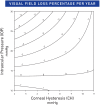Corneal Hysteresis as a Biomarker of Glaucoma: Current Insights
- PMID: 32848355
- PMCID: PMC7429407
- DOI: 10.2147/OPTH.S236114
Corneal Hysteresis as a Biomarker of Glaucoma: Current Insights
Abstract
The diagnosis and management of glaucoma has long been dependent on making decisions based on family history, optic nerve head evaluation, intraocular pressure, visual field testing, and optical coherence testing. Other pieces to aid in understanding glaucoma have presented throughout the years, including the role of corneal thickness. The discussion and debate on the mechanism of glaucoma have been attributed to resistance at the level of the conventional outflow pathway, perfusion pressure to the optic nerve head, cerebral spinal fluid pressure, and many more. Another piece that has emerged is corneal hysteresis, an assessment of the cornea's ability to absorb and dissipate energy. There is abundant published literature supporting corneal hysteresis being associated with the presence and severity of glaucoma, the structural and functional progression of glaucoma, and the conversion to glaucoma. The supported data in these studies add another piece, corneal hysteresis, to consider in the diagnosis and management of glaucoma.
Keywords: corneal biomechanics; corneal hysteresis; glaucoma.
© 2020 Zimprich et al.
Conflict of interest statement
Dr Justin A Schweitzer reports personal fees from fReichertoutside the submitted work. The authors report no other conflicts of interest in this work.
Figures



References
Publication types
LinkOut - more resources
Full Text Sources

